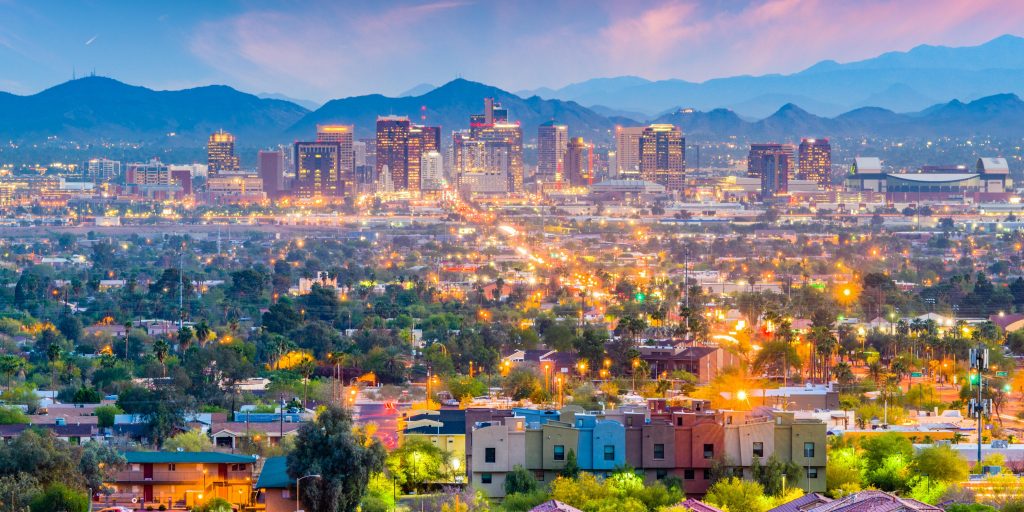Taking on the heat with tech: Cities create chief heat officers
Usually, my writing has focused on all things tech leadership in local government. And if the term “heat” was ever mentioned, it was directed towards either IT or the CIO. Given all the weather tragedies across the globe it is time we simply stop just talking about it and start doing something about it.
This time it is about heat.
Recently CBS, NBC, and CNN covered the significance of cities hiring “chief heat officers.” The first in the nation was Phoenix. Prior to all the national attention, I had the opportunity to interview David Hondula for my podcast CompTIA Sharkbytes. Hondula’s formal title is director, office of heat response and mitigation. The office is charged with developing a strategic action plan to address the growing hazard of urban heat. During the podcast, Hondula commented, “weather is an awe-inspiring phenomenon that captures the attention of everyone at some point in their lives, but it’s also powerful and can be deadly as well. When we think of life-threatening weather, hurricanes, severe storms, and flooding come to mind first, but extreme heat is one of the leading killers when it comes to weather-related fatalities.” The city of Phoenix is keenly aware of this, ranking near the top for hottest cities in the United States. This is also one of the reasons why the city, with full backing of the mayor and city council, became the first in the nation to have a publicly funded office for heat response and mitigation. Soon thereafter, Los Angeles and Miami also created chief heat officer positions.
You don’t have to be a scientist to know that weather patterns are changing in terms of heat, drought, where storms have become more powerful and violent and rain events in particular produce dramatic flooding. Experts say that for every rise in degree temperature, the atmosphere can hold approximately 4 percent more water. And as temperatures rise, huge amounts of water from our oceans and the Gulf fuel the atmosphere with increased water. Add rising temperatures and you have climate change. This helps explain why we are seeing more rain concentrated in a shorter amount of time due to this added moisture. And we know that there is a critical difference in having three inches of rain fall in a day as compared to three inches in an hour. Our infrastructure is simply not able to handle such intensity.
Heat as the culprit has become more than an annoyance and indeed has led to a tremendous loss of life and destruction of property. And for any remaining doubters out there regarding climate change, just go visit the National Oceanographic and Atmospheric Administration’s (NOAA) website and check out their Global Climate Dashboard. Closer to home, urban and suburban areas are particularly susceptible to heat risk due to the “urban heat island” effect, where roads, parking lots, buildings and other elements of the built environment absorb and radiate significantly more heat than green, grassy and natural landscapes.
Climate change has become a growing threat and technology in all sectors will need to step up and play a greater role in both mitigation and strategic planning. Here are just a few examples.
GIS
GIS systems are playing an increasingly important role in better understanding the risks involved with changes in weather. GIS serves as an invaluable tool for not only informing public managers but citizens too. Planners can do a multitude of “what-ifs” projections and simulations when it comes to rising water levels in coastal areas, river flow and capacity that can lead to advance warnings, and heat reflection and surface maps to help gauge the amount of heat either absorbed or radiated back into the atmosphere. GIS can help planners see how tree canopies can be maintained and cared for. GIS can assist heat mitigation strategies by taking weather data from NOAA and overlaying maps broken down to streets and blocks to better understand and inform. Maps can also show how the land mass is changing over time.
IoT
The internet of things (IoT) has become an ever-growing network of telemetry and data broadcasting and sharing. Sensors and gauges are found everywhere sending billions worth of data each day, making it possible to show trends and help predict future events in real-time. Add machine learning and artificial intelligence, and we can process and make sense of raw data in milliseconds as opposed to days or weeks. For example, weather prediction has become far more accurate then just five years ago due to better real-time data from water (river and ocean) sensors, satellites, weather balloons, and shared with other agencies around the globe.
Drones
Drones are playing an expanded role when it comes to weather. They are being used to surveil water ravaged neighborhoods where it is either impossible or unsafe to navigate. They can provide situational awareness as well as deliver messages and food/medical supplies to hard-to-get-to areas. They can search for survivors and those in need of medical attention
Transportation
As heat increases the wear and tear of government vehicles, extra pressure will be added to ensure that air conditioning is working properly. Better shaded and protected bus stops and shelters will need to be built to protect passengers and help maintain public acceptance of public transportation. Municipal fleet vehicles will be needed to help evacuate citizens in specified disaster zones. Preventive maintenance on all government vehicles will need to have a shorter preventative maintenance schedule leading to more pressure to maximize transportation routes as there may be less available vehicles at any given moment in time.
Public works and urban planning
While excessive heat is a problem everywhere, it is particularly hard for those who live in urban areas where “heat islands or deserts” flourish. More trees will need to be planted and maintained with state-of-the art watering techniques, roads will need to be paved with lighter heat-reflecting substances, rooftops will need to be painted with reflective paint and city streets will need to develop storm water holding tanks and ponds.
Emergency response and planning
Heat-related storms often bring significant power loss. Years back it was SOP to have battery back-up for three days for the Emergency Operations Centers, however more recently that has changed to three or more weeks. As everyone has become mobile, devices will need to have a means to be-recharged and plans need to incorporate the possible need for emergency back-up communication systems including mobile towers. Disaster preparedness plans need to include social media outreach and many jurisdictions outside of urban areas are turning back to Shortwave radio and AM radio communications. Fleets of emergency vehicles will need refueling options and especially for those who use electric power or alternative energy.
Energy use and conservation
Heat produces the need for more energy usage to cool our homes and buildings. Cities and counties will need to further their conservation efforts to stem the rising tide of energy use. Building structures will need to be modified to address the increased heat as well as building codes will need to be updated.
Citizen services
The elderly and the poor are categorically the biggest victims. Cooling centers will need to be expanded as well as communications systems that routinely check on those living alone and are the most vulnerable to heat. Fans and room air conditioners can be made available to those in most need.
Cities and counties will need to readjust their smart city strategies to focus on the impact of heat and climate inequality. This piece is by no means designed to be a comprehensive listing of all that can and should be done. The planet is heating up and heat is a growing menace that must be addressed in a comprehensive and holistic manner. What the cities of Phoenix, Los Angeles, and Miami have learned is that creating the position of chief heat officer demonstrates the need for someone to have the support and authority to bring city and county and staff together to help beat the heat. This requires an all-staff effort and sustained leadership from the highest levels of government.
Dr. Alan R. Shark is the vice president public sector and executive director of the CompTIA Public Technology Institute (PTI) in Washington D.C. since 2004. He is a fellow of the National Academy for Public Administration and chair of the Standing Panel on Technology Leadership. He is as associate professor for the Schar School of Policy and Government, George Mason University. He is also the host of the popular bi-monthly podcast, CompTIA Sharkbytes. Dr. Shark’s thought leadership activities include keynote speaking, blogging, and he is the author or co-author of more than 12 books including the nationally recognized textbook “Technology and Public Management,” and “CIO Leadership for Cities and Counties.”




















